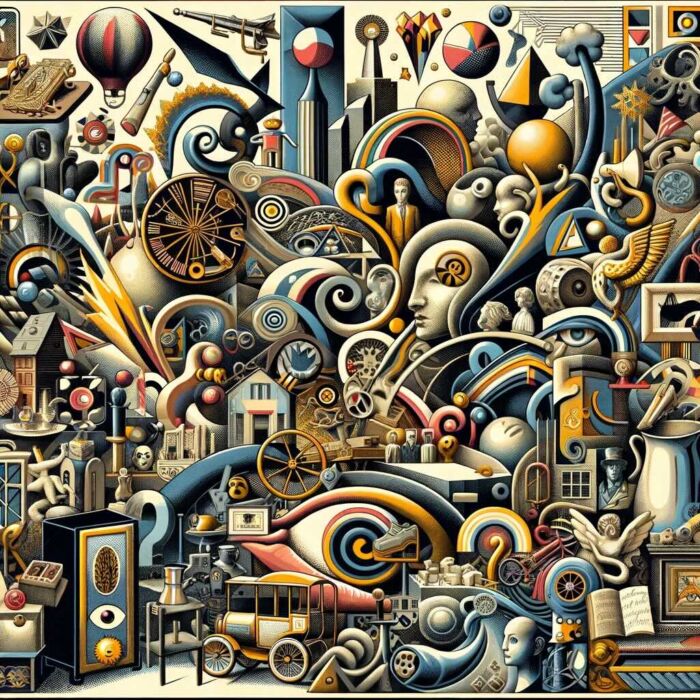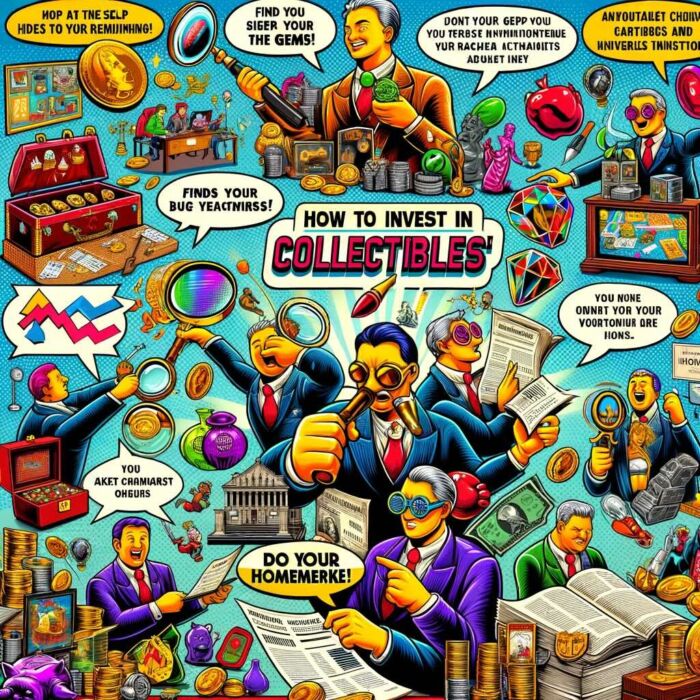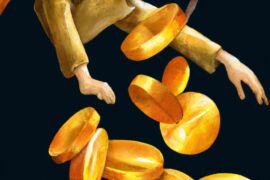Hey there, fellow investors! Are you tired of the same old boring stocks and bonds in your portfolio? Looking to spice things up and add some pizzazz to your investments? Well, have you considered collectibles?
That’s right, collectibles can be a fun and unique alternative investment option that can potentially add value to your portfolio. In this article, we’ll explore the world of collectibles as an investment and cover everything you need to know to get started.

Why diversify with alternative investments:
Before we dive into the exciting world of collectibles, let’s first talk about why it’s important to diversify your portfolio with alternative investments. While traditional investments like stocks and bonds can be stable and reliable, they can also be subject to market fluctuations and economic conditions.
By diversifying your portfolio with alternative investments like collectibles, you can potentially mitigate some of that risk and add a unique element to your investment strategy. Plus, alternative investments often have low correlation with traditional investments, which can help further diversify your portfolio and potentially increase your returns.
What are collectibles as an investment:
So, what exactly are collectibles when it comes to investing? Collectibles are essentially any item that is valued for its rarity, uniqueness, historical significance, or aesthetic appeal. This can include things like artwork, rare books, stamps, coins, vintage cars, and more.
Collectibles can be a bit different from other types of alternative investments, like real estate or commodities, because they are often more subjective in value. The value of a collectible can depend on things like market demand, condition, rarity, and provenance. However, for those who are passionate about a particular type of collectible, the potential for appreciation can be significant.
By the end of this article, you’ll have a solid understanding of what collectibles are as an investment, and whether they may be a good fit for your portfolio. So, buckle up and let’s dive into the world of collectibles!

Potential Benefits Of Investing In Collectibles
Investing in collectibles is a unique way to diversify your investment portfolio and potentially reap some great rewards. While traditional investments like stocks and bonds may offer more stability, collectibles can provide a range of benefits that are difficult to find elsewhere. Here are some of the benefits of investing in collectibles:

A. Potential for long-term growth and income: Collectibles, such as rare coins, stamps, or art pieces, often appreciate in value over time. While there may be fluctuations in the short term, historical data shows that many collectibles have steadily increased in value over the years. If you have a discerning eye and can identify pieces that are likely to appreciate in value, then you may be able to earn a significant return on your investment.
B. Low correlation with other asset classes: Collectibles tend to have low correlation with traditional asset classes, such as stocks and bonds. This means that their value doesn’t fluctuate in the same way that traditional assets do. This makes collectibles an attractive option for investors who are looking to reduce their overall portfolio risk.
C. Enjoyment and hobby aspects: Unlike traditional investments, collectibles can provide enjoyment and entertainment in addition to potential financial gain. Collectors often develop a deep appreciation for their chosen items, whether it be a rare piece of jewelry or a vintage comic book. This passion can add an extra layer of enjoyment to the investment experience.
D. Potential for tax benefits: Collectibles may offer certain tax benefits, depending on the country and the specific collectible. For example, in the United States, certain collectibles are considered “collectibles” and may be subject to a lower capital gains tax rate. Additionally, some countries offer tax breaks for donating collectibles to charitable organizations. As always, when it comes to tax issues, you’ll want to do your own due diligence and check the latest regulations and rules.
source: Reserved Investments on YouTube

Risks & Challenges Of Investing In Collectibles
Investing in collectibles can provide a unique and potentially rewarding investment experience. However, it’s important to do your research and be prepared for the risks and challenges that come with investing in this alternative asset class.
Investing in collectibles can be a lucrative way to diversify your investment portfolio, but it’s important to consider the risks and challenges that come with it. Here are some potential drawbacks to keep in mind:
A. High upfront costs: Collectibles often require a significant investment upfront, whether it’s a rare piece of art, a vintage car, or a rare coin. It can be difficult to find and purchase high-quality collectibles, and the cost of entry can be prohibitively high for some investors.
B. Lack of liquidity: Collectibles are generally not as easy to buy and sell as stocks or bonds, and there is often a limited market for them. This can make it challenging to cash out your investment when you need to, and you may need to hold onto your collectibles for longer periods of time to see a return.
C. Risk of fraud and counterfeiting: The collectibles market is rife with fraudulent activity, and it can be difficult to verify the authenticity and value of certain items. This is especially true for items that are highly sought after, as there may be a higher incentive for fraudsters to create counterfeit versions.
D. Dependence on external factors such as market trends and popularity: The value of collectibles can be highly dependent on market trends and the popularity of certain items. For example, if a particular artist or style falls out of favor, the value of related collectibles may drop significantly. It can be difficult to predict which items will be popular in the future, making it challenging to make informed investment decisions.
Moreover, it’s important to approach collectibles as a long-term investment and to thoroughly research and verify the authenticity and value of any items before investing. It’s also important to diversify your investments and not rely solely on collectibles as a source of income.

How To Invest In Collectibles
Investing in collectibles can be a unique and exciting way to diversify your portfolio. However, it’s important to carefully consider the different investment options and factors before jumping in. Here are some ways to invest in collectibles:

A. Direct ownership of collectibles vs. investing in collectible funds or portfolios:
One way to invest in collectibles is to directly purchase and own them. This can include a wide range of items such as art, rare books, coins, stamps, and sports memorabilia. Another option is to invest in collectible funds or portfolios managed by professionals, which can provide access to a wider range of items and potentially diversify risk.
B. Factors to consider when selecting collectible investments, such as rarity, condition, and provenance:
When investing in collectibles, it’s important to consider the rarity, condition, and provenance of the item. Rarity can greatly impact the value of a collectible, as well as its potential for appreciation. Condition is also important, as even small imperfections can greatly affect the value of an item. Provenance, or the item’s ownership history, can also impact its value and authenticity.
C. Storing and managing collectible investments:
Proper storage and management of collectibles is crucial for maintaining their value and condition. Depending on the type of collectible, this can include measures such as climate-controlled storage, professional handling, and regular inspections. It’s also important to have insurance coverage to protect against damage or loss.
Overall, investing in collectibles can offer unique benefits and challenges. It’s important to carefully consider your goals, investment options, and potential risks before making any investment decisions. Consulting with a financial advisor who specializes in alternative investments can also provide valuable guidance.
source: Patrick Desjardins on YouTube

Potential Performance Of Collectible Investments
Investing in collectibles has been gaining popularity as an alternative investment strategy. It is known to offer potential long-term growth and income, low correlation with other asset classes, and the enjoyment of collecting items that have sentimental or historical value. However, investing in collectibles also poses risks and challenges such as high upfront costs, lack of liquidity, the risk of fraud and counterfeiting, and dependence on external factors such as market trends and popularity.
It is also worth noting that the collectibles market, like any other market, is subject to fluctuations and trends. Some categories of collectibles may experience a sudden surge in demand, driving up prices in a short period, while others may experience a drop in value due to changing tastes or market conditions. Therefore, it is crucial to consider historical performance as well as potential future outlook before investing in collectibles.
Investing in collectibles can offer a unique and enjoyable investment opportunity with the potential for long-term growth and income. However, it also comes with risks and challenges that need to be carefully evaluated. When considering investing in collectibles, it is essential to seek advice from a financial advisor and do thorough research on the collectibles market, including the specific category of collectibles you are interested in.
source: HBS Online on YouTube

Other Alternatives To Invest In Aside From Collectibles
When it comes to diversifying a portfolio with alternative investments, collectibles are just one option. Other alternatives exist that may fit an investor’s needs and preferences better.
A. Real estate can offer long-term growth and income potential. Direct ownership of rental properties can provide steady rental income and appreciation over time, while investing in real estate investment trusts (REITs) offers an opportunity to invest in real estate without the hassle of direct property management.
B. Timberland is another alternative investment that has the potential for long-term growth and income. Similar to real estate, direct ownership of timberland allows for harvesting and selling of timber for profit, while investing in timberland funds or REITs offers an opportunity to invest in timberland without the hassle of direct ownership and management.
C. Commodities, such as precious metals, oil, and agricultural products, have been a popular alternative investment for centuries. Commodities have the potential for long-term growth and provide diversification benefits, as they typically have low correlation with traditional asset classes. However, investing in commodities can be complex and requires knowledge of the commodities market.
D. Wine, like collectibles, offers a unique investment opportunity. Investing in fine wine can provide potential for long-term growth and income, and offers enjoyment as a hobby. However, like collectibles, wine investments can be subject to high upfront costs and lack of liquidity.
While collectibles are one alternative investment option, there are many other alternatives that may better fit an investor’s needs and preferences. It’s important to research and carefully consider the benefits and risks of each alternative investment option before investing.
source: David Aaron Carpenter on YouTube
Collectibles Final Thoughts
Investing in collectibles can be a unique and rewarding experience, but it is important to weigh the benefits against the risks. On the positive side, collectibles have the potential for long-term growth and income, and can provide an enjoyable hobby for the investor. Additionally, investing in collectibles has the potential for tax benefits and can be a low-correlation asset class.

However, there are also risks to consider, including high upfront costs, lack of liquidity, risk of fraud and counterfeiting, and dependence on external factors such as market trends and popularity. It is important for investors to carefully consider these risks and assess whether they are comfortable taking them on.
For those interested in investing in collectibles, it is recommended to consult with a financial advisor before making any decisions. A financial advisor can help guide the investor in selecting the right collectibles to invest in, and can assist with managing and storing the investments. By taking the time to carefully consider the benefits and risks, and seeking guidance from a professional, investors can make informed decisions and potentially reap the rewards of investing in collectibles as part of a diversified portfolio.
Important Information
Investment Disclaimer: The content provided here is for informational purposes only and does not constitute financial, investment, tax or professional advice. Investments carry risks and are not guaranteed; errors in data may occur. Past performance, including backtest results, does not guarantee future outcomes. Please note that indexes are benchmarks and not directly investable. All examples are purely hypothetical. Do your own due diligence. You should conduct your own research and consult a professional advisor before making investment decisions.
“Picture Perfect Portfolios” does not endorse or guarantee the accuracy of the information in this post and is not responsible for any financial losses or damages incurred from relying on this information. Investing involves the risk of loss and is not suitable for all investors. When it comes to capital efficiency, using leverage (or leveraged products) in investing amplifies both potential gains and losses, making it possible to lose more than your initial investment. It involves higher risk and costs, including possible margin calls and interest expenses, which can adversely affect your financial condition. The views and opinions expressed in this post are solely those of the author and do not necessarily reflect the official policy or position of anyone else. You can read my complete disclaimer here.






